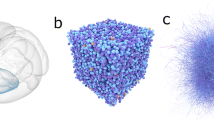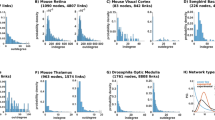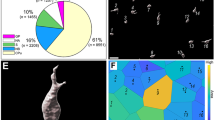Abstract
The phenomena related to brain function occur as the interplay of various modules at different spatial and temporal scales. Particularly, the integration of the dynamical behavior of cells within the complex brain topology reveals a heterogeneous multi-scale problem, which has, to date, mainly been addressed by methods of statistical physics such as mean-field approximations. In contrast, the present study introduces an abstract mathematical model of a deterministic nature that provides a robust integral transformation of the microscopic activities into macroscopic spatiotemporal patterns. The existence of the transformation operator is guaranteed by the convergence of a repetitive patching of the network domain with its fundamental domains that express the local topologies of the tissue. Depending on the choice of the local connectivity function, this framework represents a computationally efficient generalization of the classical Kirchhoff’s, Hebbian, and Hopfield’s approaches. The capabilities of this multi-scale method have been evaluated within the structure of the dorsal striatum of rats, a brain region with major involvement in motor and cognitive information processing. Numerical simulations suggest the formation of characteristic spatiotemporal patterns due to the activation of cholinergic interneurons.


Similar content being viewed by others
References
Albert, R., Barabasi, A.L.: Topology of complex networks: local events and universality. Phys. Rev. Lett. 85, 5234 (2000)
Albert, R., Barabasi, A.L.: Statistical mechanics of complex networks. Rev. Mod. Phys. 74, 47–97 (2002)
Albert, R., Othmer, H.G.: The topology of the regulatory interactions predicts the expression pattern of the segment polarity genes in Drosophila melanogaster. J. Theor. Biol. 223, 1–18 (2003)
Jeong, H., Tombor, B., Albert, R., Oltvai, Z.N., Barabasi, A.L.: Topological properties of metabolic networks. Nature 407, 651–654 (2000)
Kiss, T., Erdi, P.: Mesoscopic neurodynamics. Biosystems 64, 119–126 (2002)
Amari, S.: Field theory of self-organizing neural nets. IEEE Trans. Syst. Man Cybern. 13, 741–748 (1983)
Grifth, J.A.: A field theory of neural nets. I. Derivation of field equations. Bull. Math. Biophys. 25, 111–120 (1963)
Wilson, H.R., Cowan, J.: A mathematical theory of the functional dynamics of cortical and thalamic neurons tissue. Kybernetik 13, 55–80 (1973)
Ventriglia, F.: Kinetic approach to neural systems. Bull. Math. Biol. 36, 534–544 (1974)
Ventriglia, F.: Neural Modeling and Neural Networks, Chapter Towards a Kinetic Theory of Cortical-Like Neural Fields, pp. 217–249. Pergamon Press, Oxford (1994)
Chronister, R.B., Farnell, K.E., Marco, L.A., White, Jr. L.E.: The rodent neostriatum: a Golgi analysis. Brain Res. 108, 37–46 (1976)
Herkenham, M., Edley, S.M., Stuart, J.: Cell clusters in the nucleus accumbens of the rat, and the mosaic relationship of opiate receptors, acetylcholinesterase and subcortical afferent terminations. Neuroscience 11, 561–593 (1984)
Mensah, P.L.: The internal organization of the mouse caudate nucleus: evidence for cell clustering and regional variation. Brain Res. 137, 53–66 (1977)
Mensah, P.L.: Distribution of the largest neuron in mouse caudate-putamen nucleus: its position in large-cell-medium-cell clusters. Exp. Brain Res. 38, 267–271 (1980)
Andersson, C., Hamer, R.M., Lawler, C.P., Mailman, R.B., Lieberman, J.A.: Striatal volume changes in the rat following long-term administration of typical and atypical antipsychotic drugs. Neuropsychopharmacology 27, 143–151 (2002)
Oorschot, D.E.: Total number of neurons in the neostriatal, pallidal, subthalamic, and substantia nigral nuclei of the rat basal ganglia. J. Comp. Neurol. 366, 580–599 (1996)
Carrillo-Reid, L., Tecuapetla, F., Tapia, D., Hernandez-Cruz, A., Galarraga, E., Drucker-Colin, E., Bargas, J.: Encoding network states by striatal cell assemblies. J. Neurophysiol. 99, 1435–1450 (2008)
Grillner, S.: Biological pattern generation: the cellular and computational logic of networks in motion. Neuron 52, 751–766 (2006)
Pisani, A., Bernardi, G., Ding, J., Surmeier, D.J.: Re-emergence of striatal cholinergic interneurons in movement disorders. Trends Neurosci. 30, 545–553 (2007)
Kemp, J.M., Powell, T.P.: The synaptic organization of the caudate nucleus. Philos. Trans. R. Soc. Lond. B Biol. Sci. 262, 403–412 (1971)
Gerfen, C.R., Engber, T.M., Mahan, L.C., Susel, Z., Chase, T.N., Monsma, Jr. F.J., Sibley, D.R.: D1 and D2 dopamine receptor-regulated gene expression of striatonigral and striatopallidal neurons. Science 250, 1429–1432 (1990)
Grofova, I.: The identification of striatal and pallidal neurons projecting to substantia nigra: an experimental study by means of retrograde axonal transport of horseradish peroxidase. Brain Res. 91, 286–291 (1975)
DiFiglia, M., Pasik, P., Pasik, T.: A Golgi study of neuronal types in the neostriatum of monkeys. Brain Res. 114, 245–256 (1976)
Gerfen, C.R.: Synaptic organization of the striatum. J. Electron Microsc. Tech. 10, 265–281 (1988)
Bolam, J.P., Wainer, B.H., Smith, A.D.: Characterization of cholinergic neurons in the rat neostriatum. A combination of choline acetyltransferase immunocytochemistry, Golgi-impregnation and electron microscopy. Neuroscience 12, 711–718 (1984)
Kawaguchi, Y.: Large aspiny cells in the matrix of the rat neostriatum in vitro: physiological identification, relation to the compartments and excitatory postsynaptic currents. J. Neurophysiol. 67, 1669–1682 (1992)
Kawaguchi, Y.: Physiological, morphological, and histochemical characterization of three classes of interneurons in rat neostriatum. J. Neurosci. 13, 4908–4923 (1993)
Kawaguchi, Y., Wilson, C.J., Augood, S.J., Emson, P.C.: Striatal interneurones: chemical, physiological and morphological characterization. Trends Neurosci. 18, 527–535 (1995)
Tashiro, Y., Sugimoto, T., Hattori, T., Uemura, Y., Nagatsu, I., Kikuchi, H., Mizuno, N.: Tyrosine hydroxylase-like immunoreactive neurons in the striatum of the rat. Neurosci. Lett. 97, 610 (1989)
Betarbet, R., Turner, R., Chockkan, V., DeLong, M.R., Allers, K.A., Walters, J., Levey, A.I., Greenamyre, J.T.: Dopaminergic neurons intrinsic to the primate striatum. J. Neurosci. 17, 6761–6768 (1997)
Dube, L., Smith, A.D., Bolam, J.P.: Identification of synaptic terminals of thalamic or cortical origin in contact with distinct medium-size spiny neurons in the rat’s neostriatum. J. Comp. Neurol. 267, 455–471 (1988)
Flores-Hernandez, J., Galarraga, E., Bargas, J.: Dopamine selects glutamatergic inputs to neostriatal neurons. Synapse 25, 185–195 (1997)
Freund, T.F., Powell, J.F., Smith, A.D.: Tyrosine hydroxylase-immunoreactive boutons in synaptic contact with identified striatonigral neurons, with particular reference to dendritic spines. Neuroscience 13, 1189–1215 (1984)
Beckstead, R.M.: A pallidostriatal projection in the cat and monkey. Brain Res. Bull. 11, 629–632 (1983)
Kita, H., Kitai, S.T.: Efferent projections of the subthalamic nucleus in the rat: light and electron microscopic analysis with the PHA-L method. J. Comp. Neurol. 260, 435–452 (1987)
Bolam, J.P., Ingham, C.A., Izzo, P.N., Levey, A.I., Rye, D.B., Smith, A.D., Wainer, B.H.: Substance P-containing terminals in synaptic contact with cholinergic neurons in the neostriatum and basal forebrain: a double immunocytochemical study in the rat. Brain Res. 397, 279–289 (1986)
Bourgain, J.: On Lipschitz embedding of metric spaces in Hilbert space. Isr. J. Math. 151, 111–124 (1985)
Rayport, S.: Visualizing striatal networks. Focus on: encoding network states by striatal assemblies. J. Neurophysiol. 99, 1053–1054 (2008)
Hopfield, J.J.: Neural networks and physical systems with emergent collective computational abilities. Proc. Natl. Acad. Sci. USA 79, 2554–2558 (1982)
Boraud, T., Brown, P., Goldberg, J.A., Graybiel, A.M., Magill, P.J.: Oscillations in the basal ganglia: the good, the bad, and the unexpected. In: The Basal Ganglia, vol. VIII, pp. 3–25 (2005)
Alexander, G.E., Wickens, J.R.: Analysis of striatal dynamics: the existence of two modes of behavior. J. Theor. Biol. 163, 413–438 (1993)
Wickens, J.R., Kotter, R., Alexander, M.E.: Effects of local connectivity on striatal function: simulation and analysis of a model. Synapse 20, 281–298 (1995)
Fenno, L., Yizhar, O., Deisseroth, K.: The development and application of optogenetics. Annu. Rev. Neurosci. 34, 389–412 (2011)
Spanagel, R., Bartsch, D., Brors, B., Dahmen, N., Deussing, J., Eils, R., Ende, G., Gallinat, J., Gebicke-Haerter, P., Heinz, A., Kiefer, F., Jäger, W., Mann, K., Matthäus, F., Nöthen, M., Rietschel, M., Sartorius, A., Schütz, G., Sommer, W.H., Sprengel, R., Walter, H., Wichmann, E., Wienker, T., Wurst, W., Zimmer, A.: An integrated genome research network for studying the genetics of alcohol addiction. Addict. Biol. 15, 369–379 (2010)
Acknowledgements
This work was supported by the Bundesministerium für Bildung und Forschung (NGFN Plus; FKZ: 01GS08152, FKZ: 01GS08155 see under www.ngfn-alkohol.de and Spanagel et al. [44]; FKZ: 01GS08151 and funding from the Bernstein Center for Computational Neuroscience initiative; FKZ: 01GQ1003B).
Author information
Authors and Affiliations
Corresponding author
Rights and permissions
About this article
Cite this article
Noori, H.R. Multi-scale modeling of complex neuronal networks: a view towards striatal cholinergic pattern formations. J Biol Phys 38, 597–606 (2012). https://doi.org/10.1007/s10867-012-9274-8
Received:
Accepted:
Published:
Issue Date:
DOI: https://doi.org/10.1007/s10867-012-9274-8




